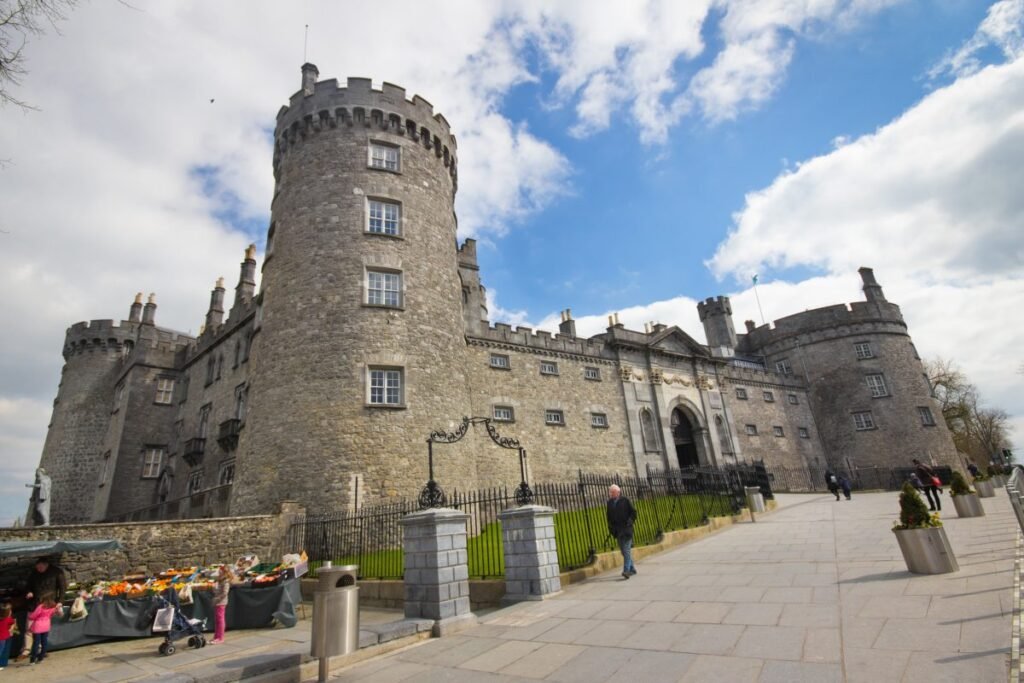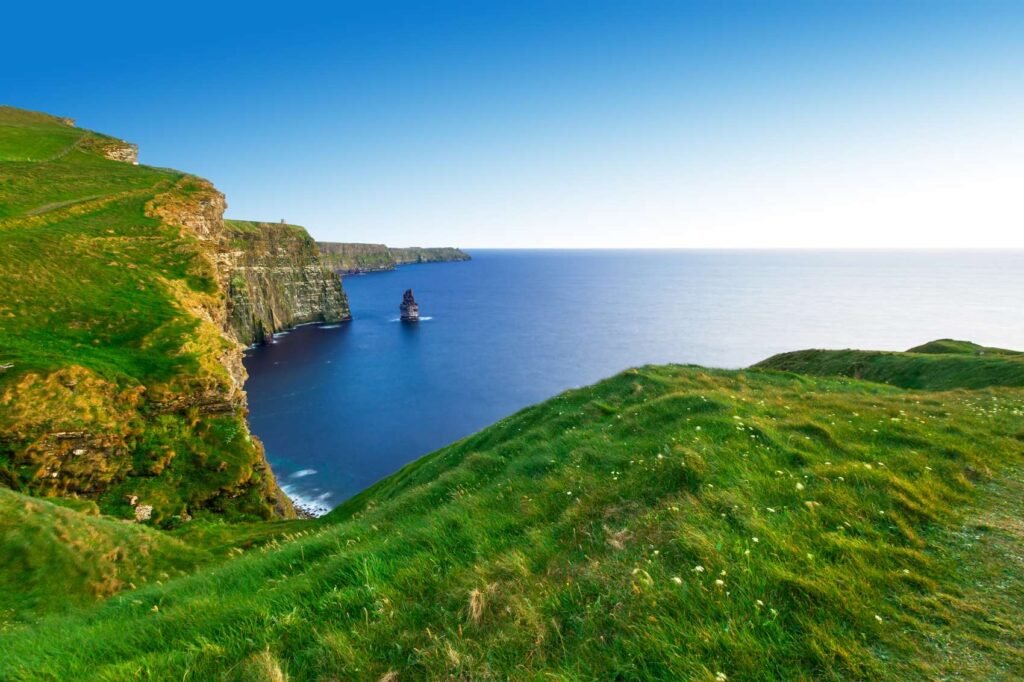County Tipperary, located in the heart of Ireland, offers a rich tapestry of historical sites, natural wonders, and cultural experiences for tourists to explore. From ancient castles and religious landmarks to scenic landscapes and adventure parks, this county has something for every type of traveler. Here are the top 12 places for tourists to see in County Tipperary, each offering a unique glimpse into the region’s heritage and beauty.

Rock of Cashel
The Rock of Cashel is undoubtedly the crown jewel of County Tipperary’s attractions. This iconic limestone outcrop, rising dramatically from the surrounding plains, is home to a collection of medieval ecclesiastical buildings that date back to the 12th and 13th centuries. Visitors can explore the round tower, Cormac’s Chapel, and the cathedral, all of which showcase stunning examples of Romanesque and Gothic architecture.The site’s rich history as the seat of the Kings of Munster before being gifted to the church in 1101 adds to its allure. With breathtaking views of the surrounding countryside and a wealth of Celtic art and medieval architecture, the Rock of Cashel offers an unparalleled journey through Ireland’s past.
Cahir Castle
Cahir Castle stands as one of Ireland’s largest and best-preserved medieval fortresses. Built in the 13th century on a rocky island in the River Suir, this imposing structure was once the stronghold of the powerful Butler family. The castle’s strategic design, featuring thick walls and a defensive layout, made it nearly impregnable until it fell to heavy artillery in 1599.Today, visitors can explore the castle’s towers, courtyards, and defensive structures, gaining insight into medieval warfare and daily life. An excellent audiovisual show provides a comprehensive overview of the castle’s long and eventful history, making it a must-visit for history enthusiasts and castle lovers alike.
Glen of Aherlow
The Glen of Aherlow is a picturesque valley nestled between the Galtee Mountains and the Slievenamuck ridge. This natural wonder offers visitors a perfect blend of scenic beauty and outdoor activities. The glen features eight looped walks catering to various fitness levels, allowing hikers to experience the area’s diverse landscapes, from forest tracks to open moorland and mountain paths.At the entrance to the glen stands the iconic statue of Christ the King, offering panoramic views of the valley below. The Glen of Aherlow Nature Park provides a more relaxed setting for families and nature lovers to enjoy the local flora and fauna. With its rich mythology and stunning vistas, the Glen of Aherlow is a haven for those seeking to immerse themselves in Ireland’s natural beauty.
Mitchelstown Caves
Discovered in 1833, the Mitchelstown Caves offer visitors a fascinating underground adventure. These limestone caves, considered among the finest in Europe, feature an impressive array of stalactites, stalagmites, and other dripstone formations. Guided tours take visitors through almost half a mile of caverns, including three massive chambers that showcase nature’s subterranean artistry.The caves maintain a constant temperature of 12°C (54°F) year-round, providing a cool respite on warm summer days. The surrounding area, with views of the Galtee Mountains, offers an ideal spot for picnicking before or after exploring the underground wonders. Mitchelstown Caves provide a unique and memorable experience for visitors of all ages.
Swiss Cottage
Located just outside the heritage town of Cahir, the Swiss Cottage is a charming example of a cottage orné – a fanciful realization of an idealized countryside retreat. Built in the early 1800s by Richard Butler, the first Earl of Glengall, this ornamental cottage is believed to have been designed by the renowned Regency architect John Nash.The cottage’s interior features a graceful spiral staircase and exquisitely decorated rooms, some with original wallpaper. The restoration project in the 1980s, overseen by famous fashion designer Sybil Connolly, further enhanced its appeal. Surrounded by beautiful gardens, the Swiss Cottage offers visitors a glimpse into the refined tastes and romantic ideals of the 19th-century gentry.
Ormond Castle
Known as the best example of an Elizabethan manor house in Ireland, Ormond Castle in Carrick-on-Suir is a testament to Tudor architecture. Built by Thomas Butler, the 10th Earl of Ormond, in the 1560s, the castle is renowned for its elaborate plasterwork and architectural details that reflect the earl’s close connection to Queen Elizabeth I.Visitors can explore the castle’s state rooms, including the Long Gallery with its ornate chimney pieces and plasterwork ceiling. The castle’s unique blend of medieval tower houses with a Tudor manor offers insight into the transition of Irish architecture during this period. Ormond Castle provides a fascinating look into Ireland’s aristocratic past and its connections to the English crown.
Cashel Folk Village
The Cashel Folk Village offers visitors a unique journey through Irish history, focusing on the periods of the 1916 Easter Rising, the Irish War of Independence, and the Irish Civil War. This open-air museum features a collection of authentic thatched cottages, each dedicated to different aspects of Irish rural life and history.Exhibits include penal times, the Great Famine, and various periods of Irish rebellion against British rule. The village’s founder, Bernard Minogue, has curated an impressive collection of artifacts and memorabilia, providing a personal and engaging perspective on Ireland’s struggle for independence. Located near the Rock of Cashel, the Folk Village offers a complementary experience that brings Ireland’s more recent history to life.
Brú Ború Cultural Centre
Situated at the foot of the Rock of Cashel, the Brú Ború Cultural Centre is a celebration of Irish music, song, and dance. As an affiliate of Comhaltas Ceoltóirí Éireann, the centre plays a crucial role in preserving and promoting traditional Irish culture. The complex includes an impressive theatre, craft shop, and the ‘Sounds of History’ cultural exhibition.During the summer months, Brú Ború hosts nightly shows featuring some of Ireland’s finest traditional performers. The centre also offers visitors the opportunity to explore Irish genealogy and enjoy local cuisine in its restaurant. With its diverse offerings, Brú Ború provides a comprehensive and immersive experience of Irish culture and heritage.
Cahir Park and Swiss Walk
Cahir Park, adjacent to Cahir Castle, offers visitors a tranquil retreat and a chance to explore the natural beauty of the area. The park features well-maintained walking trails, including the picturesque Swiss Walk along the banks of the River Suir. This scenic path connects Cahir Castle to the Swiss Cottage, providing a pleasant route between these two major attractions.The park’s landscaped gardens, mature trees, and riverside views make it an ideal spot for picnics, leisurely strolls, or simply relaxing amidst nature. Birdwatchers and nature enthusiasts will appreciate the diverse flora and fauna found in the park. The combination of historical sites and natural beauty makes Cahir Park and the Swiss Walk a must-visit for those exploring the Cahir area.
Holy Cross Abbey
Holy Cross Abbey, located near Thurles, is a beautifully restored Cistercian monastery dating back to the 12th century. Named after a relic of the True Cross it once housed, the abbey has been an important pilgrimage site for centuries. The abbey’s architecture is a stunning example of Irish Gothic style, featuring intricate stone carvings and a unique “whispering arch.”Visitors can explore the abbey’s nave, transepts, and chapels, each offering insights into medieval monastic life and religious practices. The peaceful surroundings and the abbey’s riverside location add to its serene atmosphere. Holy Cross Abbey provides a profound spiritual and historical experience, making it a significant attraction for both religious pilgrims and history enthusiasts.
Lough Derg
Lough Derg, Ireland’s third-largest lake, forms part of County Tipperary’s northern border. This vast freshwater lake offers visitors a range of water-based activities and scenic beauty. The Lough Derg Blueway provides opportunities for kayaking, stand-up paddleboarding, and boat trips, allowing visitors to explore the lake’s numerous islands and inlets.The lakeside towns and villages, such as Terryglass and Dromineer, offer charming accommodations, restaurants, and pubs where visitors can experience local hospitality. Fishing enthusiasts will find Lough Derg an excellent spot for angling, with a variety of fish species. The lake’s shores also feature walking and cycling trails, providing panoramic views and access to historical sites, making Lough Derg a versatile destination for nature lovers and outdoor enthusiasts.
Fethard Horse Country Experience
The Fethard Horse Country Experience offers visitors an interactive journey through Ireland’s rich equestrian heritage. Located in the medieval town of Fethard, this modern museum explores the deep connections between the Irish people, their land, and their horses. The experience combines cutting-edge technology with traditional storytelling to bring the world of Irish horse breeding and racing to life.Visitors can engage with multimedia exhibits that showcase the history of horse racing, the science of breeding, and the impact of the equine industry on Irish culture and economy. The museum also highlights the achievements of famous Irish racehorses and the skilled individuals who work in the industry. For horse enthusiasts and those interested in a unique aspect of Irish culture, the Fethard Horse Country Experience provides an educational and entertaining visit.


